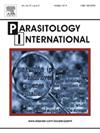鱼体表黏液成分透明质酸的趋化性
IF 1.9
4区 医学
Q3 PARASITOLOGY
引用次数: 0
摘要
Miamiensis avidus是一种海洋寄生纤毛虫,属于scuticoiliatida目,其成员是scuticoiliosis的致病因子。这种纤毛虫给韩国和日本的水产养殖业造成了相当大的经济损失。然而,疫苗和疗法的开发已被证明是具有挑战性的,目前没有关于这类产品在韩国或日本上市的报告。此外,鱼类感染黄色分枝杆菌的病原学和发病机制以及最初感染的潜在原因仍然未知。我们的目的是通过检测鱼组织的趋化反应来研究感染的机制。我们发现,M. avidus对实验中使用的橄榄比目鱼(palichthys olivaceus)标本的组织、血液和表面粘液具有高度的趋化性。我们分析了橄榄比目鱼表面黏液的成分,以确定各成分诱导趋化的程度。对其中一种成分透明质酸具有明显的化学敏感性。考虑到表面黏液的性质,我们有理由认为,黏液作为一种有效的引诱剂,可以吸引壳纤毛虫的初始寄生。本文章由计算机程序翻译,如有差异,请以英文原文为准。

Chemotaxis of Miamiensis avidus to hyaluronic acid, a component of fish surface mucus
Miamiensis avidus is a marine parasitic ciliate belonging to the order Scuticociliatida, the members of which are the causal agents of scuticociliatosis. This ciliate has resulted in considerable economic losses to the aquaculture industry in the Republic of Korea and Japan. Nevertheless, the development of vaccines and therapeutics has proven to be challenging, and there are currently no reports of such products commercially available in Korea or Japan. Furthermore, the aetiology and pathogenesis of M. avidus infection in fish remain unknown, as do the underlying reasons for the initial infection. Our goal was to investigate the mechanism of infection by examining the chemotactic response of M. avidus to fish tissues. We found that M. avidus exhibited a high degree of chemotaxis towards the tissues, blood, and surface mucus of the olive flounder (Paralichthys olivaceus) specimens used in the experiment. We analyzed the components of olive flounder surface mucus to determine the degree of chemotaxis induced by each component. Miamiensis avidus exhibited pronounced chemosensitivity to hyaluronic acid, one of the constituents. Given the nature of the surface mucus, it is plausible to suggest that it acts as a potent attractant for initial parasitism by scuticociliates.
求助全文
通过发布文献求助,成功后即可免费获取论文全文。
去求助
来源期刊

Parasitology International
医学-寄生虫学
CiteScore
4.00
自引率
10.50%
发文量
140
审稿时长
61 days
期刊介绍:
Parasitology International provides a medium for rapid, carefully reviewed publications in the field of human and animal parasitology. Original papers, rapid communications, and original case reports from all geographical areas and covering all parasitological disciplines, including structure, immunology, cell biology, biochemistry, molecular biology, and systematics, may be submitted. Reviews on recent developments are invited regularly, but suggestions in this respect are welcome. Letters to the Editor commenting on any aspect of the Journal are also welcome.
 求助内容:
求助内容: 应助结果提醒方式:
应助结果提醒方式:


